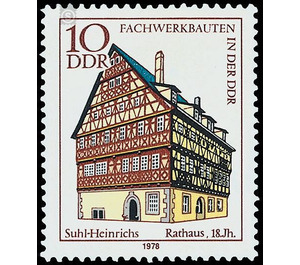Commemorative stamp series - Germany / German Democratic Republic 1978 - 10 Pfennig
Theme: Architecture
| Country | Germany / German Democratic Republic |
| Issue Date | 1978 |
| Face Value | 10.00 |
| Color | brown |
| Perforation | K 14 |
| Printing Type | Rotogravure 2 |
| Stamp Type | Postage stamp |
| Item Type | Stamp |
| Chronological Issue Number | 2036 |
| Chronological Chapter | GER-DDR |
| SID | 386019 |
| In 21 Wishlists | |
Half-timbered buildings in the GDR With the illustrations of half-timbered buildings in the GDR, the Ministry of Posts and Telecommunications of the German Democratic Republic issues five multi-colored special postage stamps. Special cancellations from January 24 to March 23, 1978 Half-timbered buildings in the GDR The half-timbered building is one of the oldest techniques for building a house. Since the 7th century wooden buildings have been attested, which indicate a processing by trained craftsmen. The oldest surviving half-timbered houses are erected as stand buildings (eg Quedlinburg, Woord 3). With them, the load-bearing trussed stalks (the so-called stands) stand on a foundation wall or, as has become customary since the 14th century, on balance beams and Fußriegeln. The upper frame timber and the bars between the uprights form the necessary static framework. With the 15th century, the individual struts of the posts and finally the connection of entire half-timbered walls by corner posts developed. The design of the sections is historically and scenically different. One of the oldest forms is the clay straw filling. In the north, bricks were often used as filling masonry. Since wood is a rapidly transient building material, much has been lost from the formerly rich timbered architecture. All the more valuable today are the preserved wooden and half-timbered houses and the few half-timbered towns such as Quedlinburg, Wernigerode, Stolberg and Osterwieck. They are all four in the area, which since the 15th Century has the richest artistic expression of half-timbered architecture. In addition, remained in other landscapes, such. In Thuringia and Lusatia, for example, the tradition of woodworking and tradesmanship comes to life and, especially in the Thuringian area, it displays rich craftsmanship and folkloristic skills, as reflected in the magnificent carvings. 10 Pfennig value: Suhl-Heinrichs, Rathaus Above the massive ground floor with corner square and Sitznischenportalen (1551) rises over strong entablature a projecting two-storey half-timbered building (late 17th, early 18th century). The richly structured pediment is decorated by tail-sawing. The half-timbering shows a multitude of ornamental figures and filling woods. The town hall is one of the most important buildings of the "Henneberger Fachwerk" as a style of Franconian-Thuringian folk architecture and is one of the poorly preserved examples, where this style is documented by its wealth of forms on the harmoniously structured façade.


